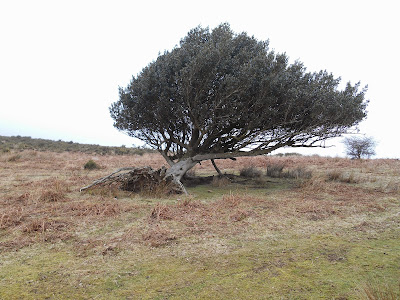Dunster Douglas was declared the tallest tree in England in 2009 when he was measured at 60.05 metres. Presumably he has grown taller since then. He is located on the Crown's Dunster Estate on an easy access trail and a short distance from the Nutcombe Bottom Car Park. He is a Douglas fir and was planted in 1876. The reasons for his record breaking height are that he is growing at the bottom of a sheltered valley in fertile soil, with plenty of water nearby and plenty of other trees to act as windbreaks. The tallest tree in Britain is also a Douglas fir. It is growing in Reelig Glen near Inverness and in 2014 was measured at 66.4 metres. Next to Dunster Douglas are two of the tallest magnolia trees in Britain. However unless you visit in spring when they are in flower, you are unlikely to notice them.
Dunster Douglas
Dunster Douglas
Dunster Douglas
Noticeboard at the foot of Dunster Douglas
Notice board with statistics about Dunster Douglas and General Sherman - the largest tree in the world. General Sherman is a giant sequoia growing in California
Tallest magnolia trees in Britain?
Tall Tree Combe
Ashbrittle Yew
Base of Ashbrittle Yew
Noticeboard in Ashbrittle Churchyard
Ashbrittle Church and Yew Tree
Inside the Ashbrittle Yew
In Turner's Barn Lane on the southern edge of Yeovil there is a beautifully trimmed conifer, which overhangs the pavement by about 6 feet. It must take some maintaining and it caught my eye.
Overhanging Tree, Turner's Barn Lane in Yeovil
Near Hawkridge on Exmoor there is a young tree growing in the stump of a large dead tree. It looks very healthy at the moment. However the tree stump is already decaying and presumably at some point in the future it will collapse and the young tree will almost certainly collapse with it, as its trunk won't be strong enough to stand up on its own, as it has always been supported by the dead tree.
Young tree growing in stump of old tree, near Hawkridge
Cutcombe area of Exmoor - toppled over but still growing
On the western edge of Stoke-sub-Hamdon, where the road into the village meets the A356, there is a solitary very tall conifer known as the Holy Tree, although I haven't been able to find out why it has this name. The junction is called Holy Tree Cross, although it is no longer a proper crossroads, as the road opposite has been blocked off at its western end where it meets the A303.
Holy Tree, Stoke-sub-Hamdon
There is a very windswept tree growing on the seafront at Clevedon. It is almost bent double. I think it is a yew tree
Windswept Tree, Clevedon Seafront
The Glastonbury Thorn is a form of common hawthorn: Crataegus monogyna 'Biflora'. However it differs from its common relative in that it flowers twice a year: in spring and at Christmas. According to legend Joseph of Arimathea visited Glastonbury and thrust his staff into Wearyall Hill, which grew into the original "Holy Thorn". This was cut down by Cromwellian troops during the English Civil War, as they regarded them as objects of superstition.
The Glastonbury Thorn, which was planted on Wearyall Hill in 1951, was chopped down by a vandal in 2010. Its replacement was also broken a few days after it was planted on Wearyall Hill in 2012. There are several Glastonbury Thorns growing around the town of Glastonbury e.g. Glastonbury Abbey and the churchyard of St John the Baptist Church. A flowering branch is sent to the sovereign every Christmas. This tradition was started in the reign of King James I.
Remains of the Holy Thorn on Wearyall Hill, looking towards Glastonbury Tor
Glastonbury Thorn, St John's Churchyard
While walking the River Parrett Trail, we came across two trees near North Perrott, which looked remarkably like African baobab trees. Baobab trees have very thick trunks, in which they store water. While I am sure that the trees we saw are not baobabs, I don't know what they are.
"Baobab" Trees near North Perrott
"Baobab" tree
The Seven Sisters are a clump of beech trees growing near the top of Cothelstone Hill on the Quantocks. However there are now only 3 of them still standing. A replacement set of trees was been planted about 40 years ago adjacent to the original ones. However these are apparently damaging an ancient monument and were scheduled to be felled. I'm not sure if this has happened.
Seven Sisters, Cothelstone Hill
Angersleigh, near Taunton
This is a tree, which is well past its prime but still growing
Oak tree on the beach near Porlock Weir
This oak tree will soon be a casualty of coastal erosion. Until about 5 years ago it was growing in a field. Since then the coastline has eroded by several metres and the pebble beach has moved inland. Presumably it will eventually succumb to salt poisoning or be washed into the sea. In the meantime it still looks healthy.
























No comments:
Post a Comment